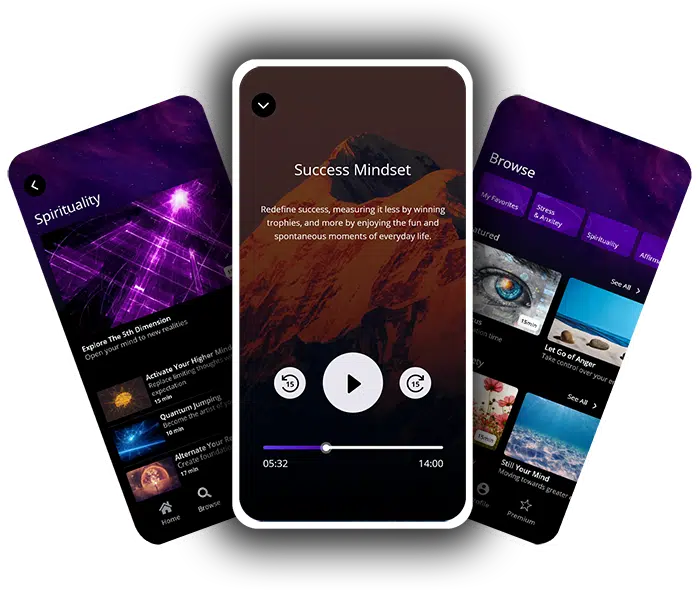Struggling to keep your breath steady while running? It’s a common challenge. Studies have found that nasal breathing, or breathing through your nose, could be the key to better performance.
This article will guide you on how to make the most of this simple yet effective technique. Get ready for a game-changer!

Unleash Your True Potential!
Explore the world of meditation with our powerful guided sessions crafted to bring peace and strength to your spirit.
But first, let’s ensure our sessions are the perfect fit for you.
Take our short quiz to find out!
Table of contents
- Understanding the Basics of Breathing While Running
- Mouth Breathing Vs. Nose Breathing While Running
- How Nasal Breathing Affects Running Performance
- Strategies to Improve Nasal Breathing While Running
- What to Do When You’re Out of Breath While Running
- How to Start Nasal Breathing While Running
- Why You Must Learn to Breathe Through Your Nose During Exercise
- Nasal Breathing Exercises to Try
- How to Practice Nasal Breathing When You’re Not Running
- Conclusion
- FAQs
- 1. Why should I breathe through my nose when running?
- 2. Can nose breathing improve my running performance?
- 3. How do I switch from mouth to nose breathing while running?
- 4. Will I need to switch back to mouth breathing at some point during my run?
- 5. What are the benefits of sticking with nasal over oral breathing while running?
- 6. Is it normal if nasal-only breathing feels difficult at first?
Understanding the Basics of Breathing While Running

Breathing while running involves the rhythm of inhaling and exhaling oxygen. The way you breathe during exercise affects your performance and overall experience.
Respiration During Exercise
During exercise, your heart and breathing rates go up to meet your body’s higher oxygen demands. This process is crucial for keeping your muscles moving. You might wonder if it’s possible to use slow, deep breathing methods while running or doing other exercises.
While it seems challenging at high intensities, rhythmic breathing techniques can indeed help with better oxygen intake.
Nasal breathing stands out as a game changer in this scenario. By focusing on nose-breathing during aerobic activities, you could boost your efficiency by a whopping 25%. Interestingly, combining mouth and nose breathing also proves effective for many runners.
Knowing the right way to breathe can make a big difference across various forms of exercise – from sprinting to marathon running.
Exercise Breathing Pattern
A good exercise breathing pattern can make all the difference in your running. Many runners use a rhythmic pattern, like belly breathing combined with a 5-step cycle—three steps for breathing in and two for letting it out.
This method helps keep your breaths deep and steady. Not only does it maintain your pace, but it also keeps you calm.
Choosing between different patterns is key. Some prefer inhaling for two steps then exhaling for one; others go with three steps in and two steps out. Both methods aim to match your breath with your stride, creating a smooth flow of movement and breath—a technique known as locomotor-respiratory coupling.
This approach boosts not just performance but also how efficiently you breathe while running.
Locomotor-Respiratory Coupling
Locomotor-respiratory coupling is all about syncing your movement and breath while running. This magic combo helps you take in oxygen more efficiently. Think of it like rhythm in music, where your steps and breaths align to create a smooth flow.
It’s not just good for your body; it can also give your mind a boost, making you feel more connected and present during your run.
This coordination might seem tricky at first but hang in there! Once you get the hang of it, running becomes easier and more enjoyable. Your body figures out how to manage oxygen better so you don’t tire as quickly.
Plus, paying attention to this sync can turn into a form of meditation on the move, helping you focus and clear your mind while boosting performance.

Unleash Your True Potential!
Explore the world of meditation with our powerful guided sessions crafted to bring peace and strength to your spirit.
But first, let’s ensure our sessions are the perfect fit for you.
Take our short quiz to find out!
Mouth Breathing Vs. Nose Breathing While Running

When running, breathing through your nose versus your mouth makes a significant difference in oxygen uptake and overall performance. Nasal breathing provides better filtration, warms the air, and increases nitric oxide production for improved endurance.
How does nose breathing differ from mouth breathing?
Nose breathing filters, warms and moistens the air for better absorption of oxygen. In contrast, mouth breathing lets air enter unfiltered and unconditioned – impacting the body’s ability to regulate temperature and moisture.
Nasal breathing also encourages deeper breaths by engaging the diaphragm more effectively than mouth breathing.
What are the benefits of breathing through your nose?
Breathing through your nose can enhance your running performance and overall well-being. Nasal breathing acts as a natural filter, keeping dust and allergens out of your airways, while also humidifying the inhaled air.
This process aids in boosting oxygen uptake and improving lung function during exercise. Additionally, nose breathing supports optimal oxygen circulation throughout the body by acting as a vasodilator, which can contribute to increased endurance and stamina.
Furthermore, compared to mouth breathing, nasal breathing allows for more efficient extraction of oxygen from the air entering the lungs during physical activity. This means that you can take in more oxygen with each breath, leading to improved athletic performance and sustainable energy levels during workouts.
Embracing nasal breathing not only benefits your running capabilities but also promotes overall health by optimizing respiratory efficiency.
How Nasal Breathing Affects Running Performance
Nasal breathing affects running performance by optimizing oxygen intake and reducing the risk of hyperventilation. It improves diaphragmatic breathing, enhances overall efficiency, and helps maintain a steady pace during exercise.
What to Do When You’re Out of Breath While Running
When you’re struggling for breath while running, slow down your pace and focus on deep belly breathing. Try inhaling through your nose and exhaling through pursed lips to regulate your breath.
Engage in diaphragmatic breathing to support optimal oxygen intake. It’s important to stay calm and steady as you recover from breathlessness.
Transitioning into the next section about “Strategies to Improve Nasal Breathing While Running” – Keep pushing forward with easy-to-apply techniques that can make a world of difference!
Can breathing through your nose while exercising improve your athletic performance?
Improving your athletic performance by breathing through your nose is a real possibility. Nasal breathing can stimulate the parasympathetic nervous system, which helps maintain heart rate and reduce stress during exercise.
Additionally, it aids in getting oxygen to working muscles more efficiently, potentially boosting overall performance. Moreover, nasal breathing has been proven to improve psychological states and decrease exercise-induced dyspnea (EID).
So, incorporating nasal breathing into your running routine could be a game-changer for enhancing your athletic capabilities.
Strategies to Improve Nasal Breathing While Running
Improve your nasal breathing while running with simple strategies. Discover modified and improved breathing patterns for better performance. Explore practical applications and advanced breath tools to enhance your running experience.
Breathing Patterns Can Be Modified and Improved
Breathing patterns can be adjusted to suit your exercise needs.
Here’s how you can modify and improve your breathing:
- Try pattern breathing, like the 2-2 pattern, to sync breath with your running pace.
- Use belly and rhythmic breathing to make your breaths more efficient while running.
- Experiment with different breath tools to find what works best for you.
Remember, modifying your breathing patterns can greatly enhance your running performance!
Advanced Breath Tools
- Explore Pranayama techniques, such as Kapalabhati and Bhastrika, to enhance breath control and mindfulness.
- Practice diaphragmatic breathing to optimize lung capacity and reduce stress during running.
- Utilize breathwork aids like breath trainers or spirometers to track and improve respiratory performance.
- Incorporate meditation and visualization techniques to synchronize breath with movement for enhanced running efficiency.
- Experiment with aromatherapy or essential oils to promote relaxation and deepen your nasal breathing practice.
- Learn about alternate nostril breathing (Nadi Shodhana) for balancing the body’s energy and enhancing endurance during runs.
- Experiment with breath – holding exercises to increase lung strength and overall respiratory fitness when running.
Practical Applications
- Begin your day with a brief meditation to focus on your breath, allowing yourself to connect with the rhythm of your inhalations and exhalations.
- Incorporate mindful breathing techniques into your running routine, concentrating on nasal breathing to improve your overall performance and endurance.
- Engage in guided imagery practices while focusing on nasal breathing during runs, enhancing mental resilience and concentration.
- Experiment with slow and intentional breathwork before and after running sessions, promoting a sense of calmness and reducing any post-exercise stress.
Using Breath Tools
Transitioning from the practical applications to using breath tools can aid in enhancing your spiritual growth and meditation practice. Here are some simple yet powerful breath tools tailored for personal growth and spirituality:
- Diaphragmatic Breathing: Engage your diaphragm by breathing deeply into your belly, allowing it to rise with each inhale and fall with each exhale. This technique helps reduce stress and promotes relaxation, essential for personal growth.
- Alternate Nostril Breathing: This ancient practice involves breathing in through one nostril, holding the breath briefly, then exhaling through the other nostril. It balances energy channels in the body, promoting a sense of inner peace and mental clarity.
- Box Breathing: Inhale for a count of four, hold for four, exhale for four, hold for four, and repeat. This rhythmic pattern instills a deep sense of calmness and focus, ideal for enhancing meditation practice.
- Breath Counting: Simply count your breaths from one to ten and start over again. Focusing on the counting enhances mindfulness and concentration, supporting personal growth endeavors.
- Equal Breathing: Inhale through the nose while counting to four, then exhale through the nose while counting to four. This balanced breathing method fosters emotional stability and assists in maintaining focus during meditation practices.
- Tongue Positioning: Place your tongue behind your upper front teeth while inhaling and keep it there as you breathe out slowly through your nose. This technique encourages relaxation and mindfulness during daily breathwork sessions.
Using these breath tools can greatly benefit those seeking to cultivate personal growth, enhance spiritual well-being, and deepen their meditation experience.
What to Do When You’re Out of Breath While Running
When you’re out of breath while running, don’t panic. Focus on slowing down your pace and taking deep breaths to regain control. It’s important to maintain proper posture and engage in rhythmic breathing to help stabilize your breathing pattern.
Techniques to recover your breath
- Practice Diaphragmatic Breathing: Place one hand on your chest and the other on your abdomen. Inhale deeply through your nose, feeling your abdomen rise. Exhale slowly and repeat to calm your breath.
- Engage in Box Breathing: Inhale for a count of four, hold for a count of four, exhale for a count of four, and then hold again for a count of four. Repeat this pattern to regulate your breathing.
- Try Alternate Nostril Breathing: Sit comfortably and close one nostril with your finger while inhaling through the other nostril. Then switch sides and exhale through the opposite nostril. This technique balances your breath.
- Maintain Good Posture: Stand or sit upright to allow maximum air intake into your lungs. Relax your shoulders and keep your chest open to support proper breathing.
- Stay Hydrated: Dehydration can affect breathing, so drink plenty of water throughout the day to keep yourself well-hydrated and maintain optimal lung function.
- Practice Progressive Muscle Relaxation: Tension can hinder breathing, so engage in muscle relaxation exercises by consciously tensing and relaxing different muscle groups to ease physical stress.
- Use Aromatherapy: Certain scents like eucalyptus or peppermint can help open up nasal passages, making it easier to breathe during exercise.
- Embrace Mindful Meditation: Calm your mind with meditation or visualization techniques to lower stress levels, which can positively impact breathing patterns during running sessions.
- Incorporate Yoga Breathing Techniques: Experiment with yoga practices such as Ujjayi breathing or Sitali cooling breath to enhance awareness of breath control and promote efficient respiration during running.
- Focus on Rhythmic Breathing: Match your breathing rhythm with your running stride by inhaling for two steps and exhaling for three steps in a steady pattern for better oxygen exchange.
How to manage your breathing rate
To manage your breathing rate while running, follow these steps:
- Start by focusing on taking slow, deep breaths.
- Concentrate on exhaling fully to remove more carbon dioxide from your body.
- Practice rhythmic breathing using belly breathing and a 5-step pattern.
- Pay attention to your posture and keep your body relaxed while running.
- Use breath tools such as alternate nostril breathing, belly breathing, or the breath of fire to enhance your respiratory control.
Remember that slow, deep breathing after exercise can help reduce heart rate and promote relaxation. By following these techniques, you can effectively manage your breathing rate and improve your overall performance while running.
How to Start Nasal Breathing While Running
To start nasal breathing while running, begin by practicing breathing techniques for beginners. Transition gradually from mouth to nose breathing, allowing your body to adapt. Keep it simple and stay consistent with your practice.
Techniques for beginners
To improve nose breathing while running and deepen your practice, here are some beginner-friendly techniques to try:
- Deep belly breaths through the nose before a run can help calm your mind and prepare your body for nasal breathing during the exercise.
- Alternate nostril breathing is a simple technique that involves inhaling and exhaling through one nostril at a time. It can help you get used to breathing through your nose and improve your lung capacity.
- Belly breathing, also known as diaphragmatic breathing, focuses on deep inhalation through the nose, allowing your belly to rise with each breath. This technique can enhance oxygen intake and promote steady nasal breathing while running.
- Slow, deep breathing exercises can assist beginners in adapting to nasal breathing during running by promoting relaxation and reducing anxiety related to breath control.
Remember, practicing these techniques consistently can help you build the habit of nasal breathing while running, leading to improved performance over time.
Transitioning from mouth to nose breathing
Transitioning from mouth to nose breathing is an essential step in improving your running and overall performance. Here are some strategies that can help you make this shift seamlessly:
- Practice nasal breathing during warm-ups and cool downs to get accustomed to the feeling.
- Start by incorporating short intervals of nose breathing during your runs, gradually increasing the duration over time.
- Focus on maintaining a relaxed jaw and facial muscles to encourage nasal breathing.
- Use breath tools such as inhaling through your nose and exhaling through your mouth to ease into nasal breathing during intense workouts.
- Pay attention to the rhythm of your breath and try to establish a comfortable pace with nasal breathing.
Remember, transitioning from mouth to nose breathing takes practice, but the benefits for both physical and mental well-being make it worth the effort.
Why You Must Learn to Breathe Through Your Nose During Exercise
Learning to breathe through your nose during exercise is crucial for improving running performance. Nasal breathing optimizes oxygen uptake, boosts running economy, and enhances overall athletic endurance.
Health benefits of nasal breathing
Nasal breathing boosts oxygen intake, filters out dust and allergens, and humidifies the air. It supports heart health during exercise by stimulating the parasympathetic nervous system.
Moreover, nasal breathing can help in extracting more oxygen from inhaled air compared to mouth breathing.
Breathing through your nose also filters the air, preventing irritants from inflaming the airways during exercise. This is crucial for those focused on personal growth and meditation as it promotes a healthier respiratory system while engaging in physical activities.
Impact on running economy
Breathing through your nose while running can positively impact your running economy. By doing so, you enable your body to utilize oxygen more efficiently, which can enhance overall performance.
Nasal breathing may contribute to a smoother and more sustainable running experience, allowing you to cover greater distances with less effort. It’s an effective strategy for optimizing your respiratory system during exercise, aiding in increased endurance and improved efficiency.
Nasal breathing during running has the potential to improve oxygen consumption and decrease the demand on your respiratory system, ultimately leading to enhanced running economy. This approach aligns with spirituality and personal growth principles as it promotes mindfulness and focus on the present moment while engaging in physical activity.
Nasal Breathing Exercises to Try
Practice these nasal breathing exercises:
1. Alternate nostril breathing – Balances your energy and promotes a calm mind.
2. Belly breathing – Enhances deep, diaphragmatic breathing for improved oxygen intake.
3. Breath of Fire – Increases lung capacity and energizes the body during running.
Alternate nostril breathing
Alternate nostril breathing, also known as Nadi Shodhana, is a yoga breathing technique that involves inhaling and exhaling through alternate nostrils. This practice aims to balance the two hemispheres of the brain, promote relaxation, and reduce anxiety.
By using this technique during meditation or as part of a daily breathing routine, you can enhance your overall well-being and mental focus. Alternate nostril breathing has been found to help relieve stress, improve concentration, and facilitate the relaxation response in the body.
It’s an effective way to calm your mind and enhance your meditation experience while promoting spiritual growth.
Belly breathing
Belly breathing, also called diaphragmatic breathing, focuses on the diaphragm muscle in your belly. This technique helps strengthen the diaphragm and makes breathing more efficient.
It can be a helpful tool to incorporate into your meditation or personal growth practices.
Remember that Belly Breathing passes knowledge of foundational techniques essential to meditation and spirituality towards mindfulness and personal development.
Breath of Fire
Breath of Fire is a powerful breathing exercise used in Kundalini yoga. It involves quick and forceful exhales paired with passive inhales, promoting improved oxygen intake and overall athletic performance.
This technique can be particularly beneficial for individuals interested in spirituality, personal growth, and meditation.
Leading to the next heading: Nasal Breathing Exercises to Try
How to Practice Nasal Breathing When You’re Not Running
To improve nasal breathing when not running, try incorporating daily techniques such as alternate nostril breathing and belly breathing into your routine. Consistent practice of these exercises can enhance your ability to breathe through your nose during exercise.
Daily exercises and techniques
- Practice alternate nostril breathing to balance the two hemispheres of your brain and improve focus.
- Engage in belly breathing exercises to calm your nervous system and reduce stress levels.
- Try the Breath of Fire technique to increase energy and clear your mind.
Benefits of consistent practice
Consistent practice of nasal breathing can enhance lung capacity and oxygen uptake, improving your overall performance. Nitric oxide produced during nasal breathing widens blood vessels, ensuring better oxygen delivery to muscles and boosting endurance.
Additionally, it filters out harmful particles, humidifies the air, and promotes respiratory health. Furthermore, consistent nasal breathing stimulates the parasympathetic nervous system fibers in the lower lungs, helping maintain a steady heart rate and promoting relaxation during exercise.
Consistent practice of nasal breathing leads to improved lung capacity, enhanced oxygen uptake for increased performance. The release of nitric oxide through this practice improves immunity and mood while filtering harmful particles for better respiratory health.
Conclusion
In conclusion, mastering nasal breathing while running can significantly enhance your performance. By altering your respiration pattern and adopting nasal breathing techniques, you can boost your athletic prowess.
With consistent practice and the use of advanced breath tools, achieving efficient nasal breathing is within reach. Embracing this change in your exercise routine could lead to improved endurance and overall well-being during physical activities.
So breathe easy, embrace the power of nasal breathing, and unlock your full potential on the track or trail.
FAQs
1. Why should I breathe through my nose when running?
Breathing through your nose, instead of your mouth, improves breathing during exercise. It helps filter and warm the air you breathe, reducing the risk of dysfunctional breathing.
2. Can nose breathing improve my running performance?
Yes! Nose breathing vs mouth breathing can enhance performance. It encourages slower, deeper breaths that increase oxygen uptake and may even reduce fatigue.
3. How do I switch from mouth to nose breathing while running?
Start with conscious breathing practices during rest. Gradually adapt to nose breathing for short runs, paying attention to how you breathe. With patience, your body will adjust.
4. Will I need to switch back to mouth breathing at some point during my run?
Initially, as you adapt to nose-breathing techniques for running—yes, switching to nasal versus oral (mouth) might feel challenging at higher intensities or speeds; it’s okay then to use both your nose and mouth.
5. What are the benefits of sticking with nasal over oral breathing while running?
Nasal breathers often experience improved slow-breathing patterns—leading to better overall stamina and reduced dryness in the throat compared with those who primarily use their mouth for air intake.
6. Is it normal if nasal-only breathing feels difficult at first?
Absolutely normal! Breathing only through your nose may feel strange or hard initially since people who usually breathe through their mouths aren’t used to it—but keep practicing; improvement comes with time.










